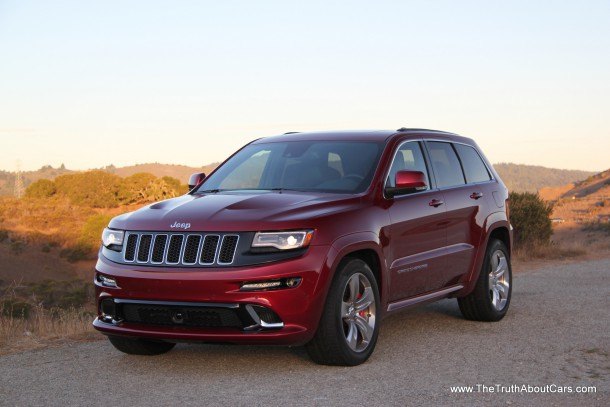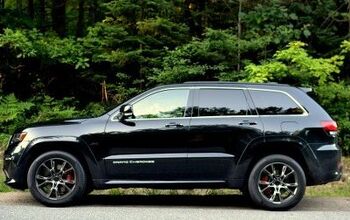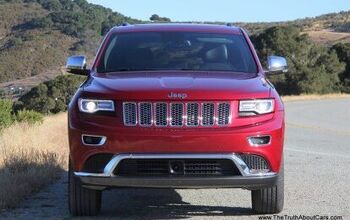Review: 2014 Jeep Grand Cherokee SRT (With Video)

If you want a high performance SUV today, you’re left with relatively little choice. GM hasn’t dabbled in the market since their Trailblazer SS / Saab 9-7 Aero and Ford never even gave it a try with the old Explorer. That means your only options for ridiculously fast boxes on wheels come from BMW, Porsche, Mercedes… and Jeep. Is it possible that the “bat-shit-crazy” Chrysler that I remember and love is back?
Exterior
This isn’t the first Grand Cherokee with sporting pretensions, as 1998 Grand Cherokee 5.9 Limited was arguably the first fast Grand Cherokee. Despite the RWD layout making a performance version “easy to do” (in a relative sense), we wouldn’t see another until the third generation “WK” SRT8 in 2006. With a 425 horsepower 6.1L engine, it was the most powerful Jeep ever built. Sadly, a Cerberus-era interior kept it off my wanted list. After a hiatus, another SRT landed in 2012, this time with 470 horses under the hood. Although improved, the interior still underwhelmed and the Mercedes sourced 5-speed transmission was hardly a team player.
While the basic vehicle remains unchanged, 2014 brings more changes than your typical refresh. Up front we have a new nose featuring LED daytime running lamps, headlamp washers and standard HID headlamps. Out back we get a refreshed rump with twin exhaust tips, which are far more practical than the central tips on first Jeep SRT,e because it allows a standard hitch receiver to be mounted behind a trim panel in the bumper. It’s worth noting that Chrysler rates the Grand Cherokee SRT for 7,200lbs of towing.
Now it’s time to talk about competition. When it comes to high horsepower SUVs, you don’t have many options. Sure, we have that new Porsche Macan, but it’s smaller than the Jeep and less powerful. When you do the numbers, the only 470+ horsepower beasts on the market are the closely related Mercedes ML63 AMG, the new supercharged Range Rovers, the Porsche Cayenne Turbo/Turbo S. And… That’s it. BMW has taken a break from X5M for 2014, likely to return as a 2015 model. Audi Q7? Too wimpy. Acura MDX? Weaksauce. That means that while the Grand Cherokee plays with the Explorer, GMC Terrain, Toyota 4Runner, VW Touareg and others, the Grand Cherokee SRT appeals to two different sorts of buyers. The performance enthusiast that wants an AWD Chrysler 300 SRT, and the luxury SUV shopper on a value hunt.
Interior
As with the exterior, 2014 brings more interior changes than your typical refresh. The Jeep gets Chrysler’s chunky new SRT steering wheel complete with metal shift paddles, a heated soft leather rim, a flat bottom, and more buttons than Apollo mission control. The refresh also brings an entirely new stitched leather dashboard, leather coated doors, carbon fiber trim, and improved plastics all around. Below the carbon fiber, little has changed. This means we still have hard plastics which belie the SRT’s luxury credentials.
Dominating the dash is the latest 8.4-inch uConnect infotainment system joined by a 7-inch LCD disco dash. The LCD gauges put the Jeep well ahead of BMW and Mercedes and, interestingly, only a notch below the full 11-inch LCD used in Range Rovers. Finishing the transformation is an Audi-like shifter in the center console. Sadly the SRT doesn’t get the Alcantara headliner that the Grand Cherokee Summit gets. Combined with the easily scratched plastic shifter surround, the SRT is obviously not running with the luxury pack but it is a notch above the crossover rabble and feels worth the $63,995 base price. More on that later.
The front seats are modified versions of regular Jeep thrones with more bolstering and are available in your choice of “baseball glove” brown or black with Alcantara inserts. (The full-leather seats will run you $1,995 more.) Although the seats are less comfortable than those found in the Merc, Rover or Bimmer, I had no problem finding a comfortable position on multi-hour drives. Unlike less expensive versions of the Grand Cherokee, the SRT’s seats seem to be designed for you to sit “in” the seat rather than “on” the seat, something that I was pleased to note. Rear seat passengers will have little to complain about with reclining rear seat backs, air vents and the same soft-touch leather door treatment as the front. New for 2014 are two high-current USB power ports in the center console so your kids can charge their iWidget without cigarette adapters.
In addition to improved voice commands for USB/iDevice control, uConnect 2 offers smartphone integration allowing you to stream audio from Pandora, iHeart Radio or Slacker Radio. You can have text messages read to you and dictate replies (if your phone supports it) and search for restaurants and businesses via Yelp. In addition to all the smartphone-tied features, uConnect 2 integrates a CDMA modem on the Sprint network into the unit for over-the-air software updates and access to the new Chrysler “App Store” where you will be able to buy apps for your car. Since there’s a cell modem onboard, uConnect can be configured to act as a WiFi hot spot for your tablets and game devices as well. Keep in mind speeds are 3G, not Sprint’s WiMAX or LTE network.
Completing the information assault is SiriusXM’s assortment of satellite data services which include traffic, movie times, sports scores, fuel prices and weather reports. As with uConnect data services, there’s a fee associated after the first few months so keep that in mind. 2014 also brings uConnect Access which is Chrysler’s answer to GM’s OnStar providing 911 assistance, crash notification and vehicle health reports. The navigation interface is easy to use, but notably less snazzy than the rest of the system’s graphics. The SRT trim gets Chrysler’s home brew 9-speaker sound system with a 506-watt amplifier. The sound is acceptable for the price tag but I’d buy the 19-speaker, $1,995 Harmon Kardon Logic7 system if I were you. Quite similar in timbre to the Logic7 systems BMW uses, the system holds its own compared to the up-level audio packages in the luxury set. Because BMW’s X5M is on hiatus, the infotainment win in this segment has to go to the SRT. COMAND is well past its prime and Porsche and Land Rover’s infotainment systems are unintuitive and lag in terms of feature functionality.
Drivetrain
The first Jeep to wear the SRT badge used a 6.1L V8 that was accused of having a narrow power band, a “peaky” torque curve and poor fuel economy. To address this, Chrysler released a new 6.4L V8 in 2012. Instead of revising the 6.1, the engineers went back to the drawing board and created a new engine based off the second-generation 5.7L Hemi. This means that unlike the luxury competition, you won’t find overhead cams, direct injection or 32 valves. Don’t let Top Gear or the iron block fool you, this engine is a modern design with some tricks up its sleeve. Despite the push rods, Chrysler managed to fit variable valve timing, a variable length intake manifold, cylinder deactivation, alloy pistons and 16 spark plugs. The combination is good for 470HP and 465 lb-ft of torque.
Thanks to the “Mercedes years”, Chrysler was still using a Mercedes 5-speed transmission behind the 3.6L V6 and the 6.4L V8 in 2012 and 2013. While not a bad transmission, the 5-speed’s ratios were not well mated to the 6.4L V8. In order to get SRT levels of performance, a different final drive was fitted making the engine spin over 2,400RPM at 70 MPH. The new ZF 8-speed automatic allows a lower effective first gear, a more balanced ratio spread and a taller final gear so the engine can at 1,900 RPM at 70. Directing power to all four wheels is an MP 3010 electronic proportioning transfer case. The driver can select from five drive modes that control the torque split, shift pattern and the dynamic suspension system. Auto gives the softest suspension, slowest shifts and sends 40% of the engine power to the front for balanced handling. Sport stiffens and makes the shifts crisper, while sending only 35% of the power to the front for more rear bias. Track provides the stiffest dampening and sends 70% of the power to the rear for even more of a RWD feel (2012 and 2013 models topped out at a 35/65 split). Should you like things 50/50, Sport and Tow modes provide balanced power front and rear. One thing you still won’t find however is a torque vectoring rear axle, Jeep retains the electronic limited slip unit found in other Grand Cherokee models.
The Grand Cherokee SRT has all the right numbers for bat-shit-crazy status, but can it deliver? In a word: Yes. Backing that answer up is a blistering 4.1 second run to 60 and an eye-popping 1.37 second 0-30 time. But can it truly compete with the Germans? Despite the new interior and 8-speed automatic (basically the same transmission Porsche, BMW and Range Rover use) the SRT isn’t as refined, inside or on the road. Driven back to back with the competition, the SRT feels more like the Range Rover or the Mercedes than the tighter BMW or Porsche. The Merc comparisons are especially interesting since the ML and the Grand Cherokee share plenty of design DNA.
Although Mercedes has fitted a more powerful twin-turbo V8 (515 HP / 516 lb0-ft or 550 HP / 560 lb-ft), the Merc feels less connected to the road than the Jeep. Part of this is due top the air ride suspension Mercedes uses and part of it is due to the narrow 265 width standard tires. While you can get 295s all the way around, it’ll cost you dearly as the ML63 is easy to option over $100,000. Factor in the dated COMAND system and the 7-speed auto that is 1 gear shy of everyone else and the ML comes in last.
Land Rover’s Ranger Rover Sport continues to march to a different drummer. Although the 5.0L V8 produces 510 HP and 461 lb-ft of twist, the Rover’s mission is more luxury than sport. The English mountain climber retains all the off road hardware of the lesser models, all season tires and a high ground clearance. Thanks to the supercharged engine’s lack of torque compared to the rest, the Range Rover is also the slowest to highway speeds. While the Range Rover would be my choice if I had the cash, the fact that it isn’t really the same kind of animal puts it in fourth place.
Porsche’s Cayenne is, without question, a beast. With sharp handling, an excellent weight balance and a well-trimmed interior you’d logically expect the Touareg’s rich cousin to take top billing. However, there’s a big value problem. In order to get 4-second 0-60 performance like the rest, you have to throw down at least $146,000 for the Turbo S model and getting crazy with the option sheet can bump your out the door by more than $25,000 without trying very hard.
BMW’s X5M would take top billing if it was still made, but, for the moment at least, there is no X5M for shoppers to contemplate. The outgoing X5M model’s torque vectoring axle, insanely wide tires, low stance and underrated twin-turbo V8 are a lethal combination. The fact that the outgoing X5M was also cheaper than the ML63 and the Cayenne certainly helps the value proposition as well. That is, if you can call a six figure vehicle a “value.”
That means that the $70,135 Jeep (as tested) is my pick for 2014. And now let’s talk about why. The fact that you could literally get two for the price of a Cayenne is huge, and that’s because I’m all about value. Value isn’t being the cheapest (although the Jeep wins that award by over $30,000 in this mash-up) it’s about delivering the same or similar experience for less, and that’s something the SRT has down. But there’s also something rough and rugged about the Jeep that elicits more charm. The Jeep’s interior is more utilitarian, the throttle blips on down shift lack the fanfare and overrun “pops” you get with the competition and there’s still that Jeep logo on the hood. More skill is required to pilot the SRT around a canyon road making it more engaging than the Teutonic competition. (It isn’t just the product that’s a little crazy, Chrysler allowed folks to drive the Jeep on Mazda Raceway Laguna Seca, other manufacturers kept their toys out of harm’s way.)
The lack of a torque vectoring rear axle means you have to be in control of the Jeep, while more refined nannies and vectoring systems in the Porsche and BMW can make anyone feel like a pro. The Cayenne and X5M are also better balanced than the Jeep which wears 54% of its weight up front thanks to that cast iron engine, but when pressed hard the Jeep gives up little to the Germans. Even in a straight line the Jeep’s numbers stack up well. Thanks to the 8-speed auto in the Jeep, and the old 6-speed ZF unit in the 2013 X5M we tested, the Jeep’s power deficit resulted in a scant 1/100th 0-30 penalty, 1/10th 0-60 penalty and by the 1/4 mile the Jeep was still neck and neck at 1/10th and 6 MPH slower.
After a week with the Grand Cherokee SRT I was sad to see it go, even after I noted my 15.5 MPG fuel economy average. Perhaps it is because I recently bought a Saab 9-7 Aer0 with GM’s 390 horse LS2, so I seem to be the target market for a value performance SUV. Perhaps it is because I’ll nver be able to afford the SRT’s German competition but the Jeep is within reach if I sell a kidney. Or, perhaps the real reason is that a 5,150lb Jeep with a 6.4L push-rod V8 engine making 470 horsepower that ticks off a 0-30 time faster than a BMW M6 rain or shine is bat-shit-crazy. Anyone know the going rate for a kidney?
Chrysler provides the vehicle, insurance and one tank of gas for this review. Chrysler provided an SRT Grand Cherokee at a Mazda Raceway event for local press.
Specifications as tested
0-30: 1.37 Seconds
0-60: 4.1 Seconds
0-100: 11.33 Seconds
1/4 Mile: 12.7 Seconds @ 107 MPH
Average observed fuel economy: 15.5 over 989 miles

More by Alex L. Dykes
Latest Car Reviews
Read moreLatest Product Reviews
Read moreRecent Comments
- Carson D I thought that this was going to be a comparison of BFGoodrich's different truck tires.
- Tassos Jong-iL North Korea is saving pokemon cards and amibos to buy GM in 10 years, we hope.
- Formula m Same as Ford, withholding billions in development because they want to rearrange the furniture.
- EV-Guy I would care more about the Detroit downtown core. Who else would possibly be able to occupy this space? GM bought this complex - correct? If they can't fill it, how do they find tenants that can? Is the plan to just tear it down and sell to developers?
- EBFlex Demand is so high for EVs they are having to lay people off. Layoffs are the ultimate sign of an rapidly expanding market.







































































Comments
Join the conversation
@Alex - Enjoy your new "Saab", and be careful with your LS2. Moving nearly 5000 lbs of SUV at ever increasing rates of speed will snap some things (your transmission). My suggestion - stop immediately and buy a transmission cooler and bypass the radiator based one. Not a question of if it will fail, only when - you will be very, very sad when your engine coolant and transmission fluid mix together like a not so yummy frothy pink milkshake. That being said, the LS2 has sooooooooo many more affordable and reliable (and easy to install) go-fast parts available for it than the Hemi, it's impossible to leave it alone once you start.
I owned a '07 Jeep SRT for 3 years and just bought the '14 about 6 months ago. The 8 speed for sure is awesome! The new brakes are way way more powerful, the old ones were good, the new are AMAZING! I test drove the '13 and just couldn't get that car knowing the 8 speed was coming with all the exterior and interior updates as well! My '07 had a hot tune with some minor bolt ons and although it sounded and felt faster, the reality is that this car is faster all around as the video points out, the freeway passing is way quicker. The best 0-60 I got so far is 4.1, while the '07 best was a 4.5. Oh and by the way, that video was shot on summit road! Some awesome roads out there to let the Jeep go!